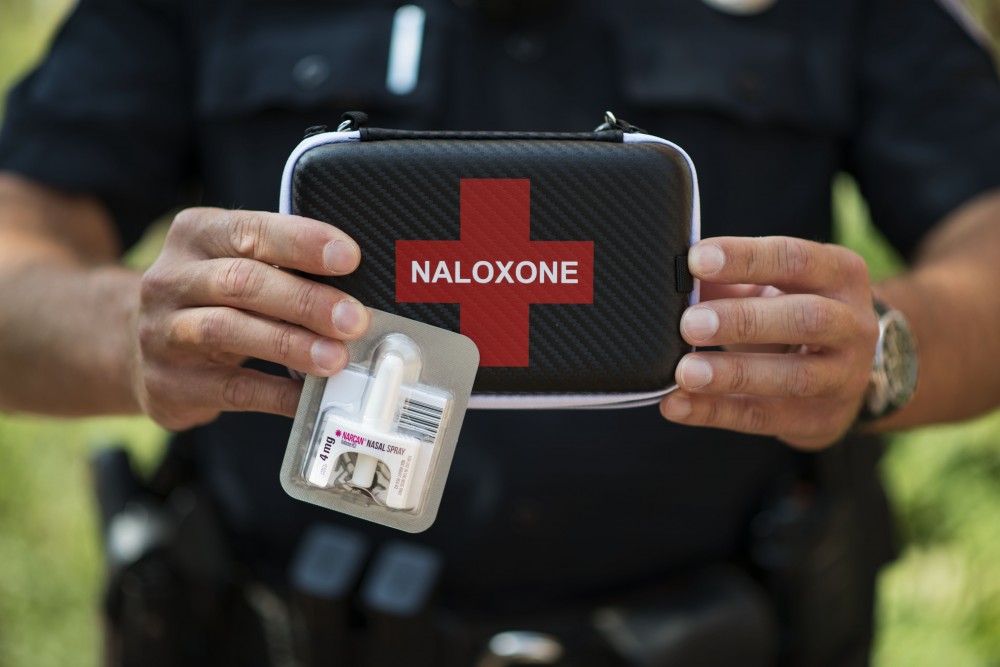As opioid overdoses in Hennepin County continue to rise, Minneapolis is increasing funding to keep up with a worsening opioid epidemic.
Minneapolis started receiving nearly $11 million in settlement funds in July as part of the U.S. attorney general’s 2021 agreement with opioid manufacturers and distributors to pay for their contributions to the opioid epidemic. The funding supports community engagement on new treatment strategies, according to Suzanne Young, senior project manager for Minneapolis’ opioid response.
In addition to the settlement funds, Minneapolis accepted a $300,000 grant from the Minnesota Department of Human Services (MDHS) on Feb. 9. The grant, which must be used by September 2024, will focus on opioid response work, including increasing public naloxone availability and educating communities on how to use it.
Naloxone, otherwise known as Narcan, is an injectable or nasal treatment that blocks the effects of opioids to reverse the effects of an overdose. According to Young, the grant will allow Minneapolis to provide resources for people struggling with substance abuse and work with communities to develop strategies to combat an evolving crisis.
“The landscape has changed, so it’s more about a response to a fentanyl crisis,” Young said. “We’ve gone from prescription medications to people getting medications on the street, and then it’s pretty much in every drug.”
Despite the number of dispensed opioids in Minnesota decreasing by roughly 28% from 2017 to 2021, opioid-related overdose deaths have hit record highs at the same time, according to the Minnesota Department of Health. Additionally, opioid-related deaths in Hennepin County involving fentanyl increased by more than 370%.
Nationally, opioid-related overdoses continue to increase, with opioids being responsible for 136 deaths per day, according to the National Center for Drug Abuse Statistics.
Fentanyl is a synthetic opioid that is up to 50 times stronger than heroin and 100 times stronger than morphine, according to the Centers for Disease Control and Prevention. While fentanyl is prescribed to treat severe pain, illegal drugs are often cut with it to make them cheaper while producing more powerful highs.
From 2018 to 2021, law enforcement saw a nearly 50-fold increase in seized pills containing fentanyl, according to a report from the National Institute on Drug Abuse. Despite the increase, many people may be unaware drugs they use contain fentanyl.
Narcan becomes more widely available
Pharmacies including Walgreens and CVS sell Narcan without a prescription. Organizations like the Steve Rummler Hope Network purchase Narcan to distribute it to people at lower prices.
“There’s a lot of different resources out there, pharmacies and such, where you can get people Narcan, and that wasn’t something you would have seen five to 10 years ago,” Trullinger said. “It’s not a cure, but it does help save people.”
Many first responders have felt the impacts of rising overdoses in the state. According to Hennepin Emergency Medical Services (EMS) spokesperson Michael Trullinger, dispatchers are responding to roughly 230 overdose calls per month.
EMS workers carry and distribute Narcan kits to people in need when they respond to calls, Trullinger said. Dispatchers also help people administer Narcan over the phone until emergency responders arrive.
Trullinger said he understands calling 911 is a “big step” for people nervous about potential legal consequences of taking illegal opioids. However, EMS services are there to rescue overdose victims and help anyone battling addiction access medical services, Trullinger said.
A 2014 state law protects anyone who experiences an overdose, administers naloxone or calls 911 from prosecution for drug possession.
“As far as Narcan … we refer to it as a rescue medication because that’s basically what it does, gives us that time to stabilize people until they get more long-term care,” Trullinger said. “It’s kind of scary, so we’ve done a lot to try and educate people on what exactly Narcan does and does not do.”
Opioid awareness nonprofit says Narcan is not enough
Colleen Ronnei founded Change the Outcome (CTO), a nonprofit that works to raise awareness for the opioid epidemic and substance abuse disorder, in 2017 after losing her son Luke to an overdose a year earlier.
According to Ronnei, increasing Narcan availability and teaching its administration works to destigmatize helping someone who is overdosing and can potentially save lives.
“If [Narcan] is accessible because it’s been funded, that helps,” Ronnei said. “There are a lot of people who don’t even recognize that they should have it. They have people in their lives who are struggling, and they don’t even know it.”
Luke’s fatal overdose in 2016 came two years into his battle with addiction after an opioid prescription turned into a heroin addiction.
After trying to understand her son’s use and relapse, Luke told her withdrawal felt like being held underwater, with drugs as the only way to come up for air.
“It rewires the brain and [using] becomes a survival mechanism,” Ronnei said. “They’re not getting high anymore — they’re just trying to survive. That’s what their brain is telling them they need to do.”
Luke compared addiction to cancer — it can be easy to overlook someone’s battle until the disease progresses.
In the six years since CTO began, Ronnei said there has been significant progress in recognizing people who overdose or battle addiction, rather than hide the problem that continues to affect more people.
However, solely providing Narcan will never be enough to fight the epidemic, Ronnei said. Instead, increased public education and awareness will help people know the risks of opioid use and prevent future addiction or misuse.
“We can revive people until the end of time — that is not going to solve the problem,” Ronnei said. “I think we can do a much better job of addressing [opioids] from a holistic standpoint.”
If you or someone you know is struggling with addiction, substance use assessments and consultations are available on Boynton Health’s website.








